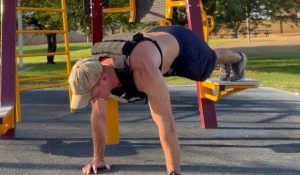Most of us have heard of (or tried) pull-up or push-up pyramid-style workouts in the past, and that’s a good thing – they are quick, effective, and they are naturally auto-regulating. If you haven’t:
Push-up and pull-up pyramids are workouts during which the lifter completes a set of an exercise, then adds (or removes) a repetition with each successive set. This “add a rep per set” scheme creates the basis of the “pyramid” or “ladder”, allowing the lifter to accumulate a lot of volume very quickly.
These workouts provide a very complete upper-body workout (or full-body, if you include a leg exercise), and can be done in 10-15 minutes. This style of workout is very popular with individuals who prefer a minimalist approach to building muscle, using simple exercises.
In addition to these pull-up and push-up pyramid workouts being quick, they are great for building muscle size and strength, and the pump is insane. Give them a try:
Method #1: Traditional pyramid push-ups and pull-ups (Ascending and descending)
Perhaps the most traditional application of the “pyramid-style” workout is the traditional, ascending and descending pyramid workout.
In a traditional pyramid, the workout would look like this:
- 1 pull-up, 2 push-ups, rest 10 seconds
- 2 pull-ups, 4 push-ups, rest 20 seconds
- 3 pull-ups, 6 push-ups, rest 30 seconds
- Etc. (continue until you believe you can’t complete the next set)
- 8 pull-ups, 16 push-ups, rest 80 seconds – “max out”
- 7 pull-ups, 14 push-ups, rest 70 seconds
- Etc. (continue back down the pyramid until you reach 1 pull-up and 2 push-ups
Pros and cons of traditional push-up and pull-up pyramids
The advantage of doing this type of pyramid is that you’ll naturally “warm up” with a basic antagonistic superset as the first few sets will feel extremely easy. Likewise, the workout also includes a natural “cool down”.
This style of pyramid workout also lends itself to being used as a standalone micro workout.
The drawback of this traditional style of pyramid is that it’s not typically the “peak” that is exceedingly difficult – most of us will have no problem ascending the pyramid and then “maxing out”. The trouble is that we’re doing near-maximal sets right after our max-effort set.
In the example above, you may find that doing one less than your max, right after you’ve done your max, leads to muscular failure in a hurry. You’ll then be participating in a miserable slog down the pyramid, which may tax your recovery resources more than you intended.
If this is the case, try the next version of the workout, the “ladder” pyramid.
Method #2: Ladder pyramids (Ascending repeats)
Though I’m sure he didn’t invent it, I first became aware of this style of pyramid workout from Johnny Pain’s now-defunct blog (StrengthVillian.com) which was home to the infamous Greyskull LP workout.
Johnny’s version of pyramid workouts acknowledged the drawbacks of traditional pyramids and he put a twist on it to accommodate for that:
- 1 pull-up, 2 push-ups, rest 10 seconds
- 2 pull-ups, 4 push-ups, rest 20 seconds
- Etc. (continue until you believe you can’t complete the next set)
- 8 pull-ups, 16 push-ups, rest 80 seconds – “max out”
- 1 pull-up, 2 push-ups, rest 10 seconds – start over at one!
- 2 pull-ups, 4 push-ups, rest 20 seconds
- Etc. (continue until you believe you can’t complete the next set)
- 5 pull-ups, 10 push-ups – max out again
- Repeat 3-4 times.
Pros and Cons of “ladder-style” pull-up and push-up pyramid workouts
In this version of the workout, we’re solving the problem of traditional pyramids:
The hardest set is followed by an easy set, rather than forcing us to complete another very difficult set directly after the peak.
If you’re using a weight vest for strength training, you can also drop weight out of the vest (or remove the vest completely) on successive ladders, allowing for more repetitions later in the workout.
The drawback of this style of workout is that there’s no defined end-point. You simply have to decide when you’ve done enough. I typically don’t do more than three “ladders”. Because of this, these workouts tend to last a bit longer.
However, I find them very motivating because it allows for true auto-regulation in multiple near-maximal effort sets.
Method #3: Armstrong pull-up pyramids

Another variation on the classic pyramid is taken directly from day two of the Armstrong pull-up program. In this version, the trainee completes the beginning of the pyramid, but rather than stopping short of failure – you attempt the next set, and then follow it with a single, all-out set to failure.
The modification here is that we are also including a simultaneous push-up pyramid workout:
In practice, it looks like this:
- 1 pull-up, 2 push-ups, rest 10 seconds
- 2 pull-ups, 4 push-ups, rest 20 seconds
- Etc. (continue until you believe you can’t complete the next set)
- 8 pull-ups, 16 push-ups, rest 80 seconds
- 6 pull-ups, 12 push-ups (attempted 9, but hit failure)
- Rest 90 seconds (what the 9-rep rest period would have been)
- Perform another all-out set to failure
Pros and cons of the Armstrong method
This method of doing pyramid workouts is extremely motivating because it takes noticeably less time than the first two methods, and it allows us to hit true muscular failure.
While we don’t always want to be hitting failure, it can be helpful once in a while. The first two variations of pyramids have you essentially guessing that you’d fail on the next set, and then declaring that the peak.
However … how sure were you? Sometimes in this variation of the workout, you’ll complete the next set and surprise yourself by doing more reps than you thought you would.
Method #4: Descending pyramids (“countdown” style)
This version of the workout turns the ascending pull-up pyramid on its head: you’ll start with the max-out, and then complete the back half of the pyramid, removing one rep at a time.
In practice, it looks like this:
- 12 pull-ups, 24 push-ups, rest 120 seconds (start with a near-maximal effort set)
- 11 pull-ups, 22 push-ups, rest 110 seconds
- 10 pull-ups, 20 push-ups, rest 100 seconds
- Etc. (down to one)
Pros and cons of countdown-style pyramid workouts
This version of the workout is hard. Why? Because we’re approaching our true max right from the first set. It can be very productive, and the muscular fatigue is insane.
However, the number of repetitions we’ll do right from the beginning will be higher, since we’re not pre-fatiguing the muscles with lower repetition sets in the beginning.
The other drawback of this method is it doesn’t include a natural warm-up like the others do. You’ll have to be responsible for warming up your joints in advance, which makes this version not quite as compact as the others.
Method #5: Juarez valley style pyramids

Originally popularized by Josh Bryant of Jailhouse Strong, the Juarez Valley push-up workout supposedly comes from prisoners in Mexico’s notorious Juarez Valley prison. A classic pyramid push-up workout, this version is not for the faint of heart.
It is a unique ascending / descending pyramid-style workout where you’ll be interspersing high-rep sets with low-rep sets simultaneously.
Pick a number of push-ups to complete, and then complete that number of reps. Walk eight feet (the width of a prison cell), and then complete one repetition. Walk back, and complete one less repetition than your first set.
Repeat until the two pyramids meet in the middle hence the name “Juarez Valley”. In practice, it looks like this (for a lifter who chose 10 as their number):
- 10 push-ups
- 1 push-up
- 9 push-ups
- 2 push-ups
- 8 push-ups
- 3 push-ups
- 7 push-ups
- 4 push-ups
- 6 push-ups
- 5 push-ups
- 5 push-ups (meet in the middle)
- 6 push-ups
- 4 push-ups
- 7 push-ups
- 3 push-ups
- 8 push-ups
- 2 push-ups
- 9 push-ups
- 1 push-up
- 10 push-ups
In order to make it a full upper body session, simply sub out one of the pyramids (either the descending or ascending one, doesn’t matter) for a pulling exercise like a pull-up or inverted row. In this case, the workout would look like this:
- 10 push-ups
- 1 inverted row
- 9 push-ups
- 2 inverted row
- 8 push-ups
- 3 inverted row
- 7 push-ups
- 4 inverted row
- 6 push-ups
- 5 inverted row
- 5 push-ups (meet in the middle)
- 6 inverted row
- 4 push-ups
- 7 inverted row
- 3 push-ups
- 8 inverted row
- 2 push-ups
- 9 inverted row
- 1 push-up
- 10 inverted row
Of course, you could increase the number of reps you start with (say, 15 or 20) in order to make this type of workout more or less taxing, as your fitness level demands.
Pros and cons of Juarez Valley push-ups and pull-ups
This version of a pyramid workout is very taxing but leads to a great pump. The disadvantage to this version is that it truly isn’t auto-regulated (like all of the other examples above). Rather than going until muscular failure, you’re expected to complete all of the sets, in order, with a predetermined number of repetitions.
This means that you’ll need to have a good idea of how many push-ups and pull-ups you can do before you begin, and it doesn’t account for good days and bad days.
That being said, it’s still a solid option and has been used effectively as a finisher on countless chest and back days by many lifters for many years.
Benefits of pyramid workouts
The workouts are quick: Most of these workouts take less than 10 minutes to complete, which is not too shabby for the level of return they provide.
They are perfect micro workouts, and can be done with very minimal equipment throughout the day.
You’ll reach true muscular fatigue: When doing this many reps, you’ll be leaving very little in the tank by the time you reach your top sets. This style of workout is great for building muscle, especially if you are doing the pull-ups and push-ups weighted.
They are naturally auto-regulating: Most of the workouts discussed in this article allow you to climb your pyramid, then stop when your body is reaching muscular failure. This means that anyone can benefit from these styles of workouts, without having to stick to a predetermined set and rep scheme.
How to make these workouts full-body
My personal favorite way of doing pyramid workouts is in a full-body style. To accomplish this is simple: simply add a leg exercise and complete the sets as a tri-set rather than a traditional superset. Possible leg exercises that work well in pyramids could be:
- Lunges (reverse, forward, walking)
- Bulgarian split squats (aka rear foot elevated split squats)
- Bodyweight squats
- Cossack squats
- Etc.
With this style, it’s easy to get a nice and compact full-body workout with little to no equipment and very little time. The pump is real!
Good luck!





















